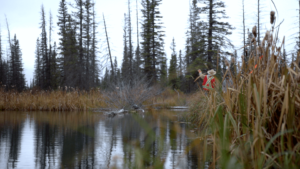Over the last 12 months, our research team has released 11 reports which dive into the future of Canada’s environmental sector and its workforce. We’ve looked at the overall trends for the sector as Canada begins post-pandemic recovery and into specific industries such as cleantech, energy-efficient buildings and nature conservation.
Our aim is to arm people, from the government to academia and businesses to individuals, with the knowledge that they need to make more informed decisions. If you’ve missed the launch of any of our recent reports, you’ll find a summary of the key findings below and details on how to read more.
Environmental Jobs and Hiring Trends
We released three reports which look at the environmental labour market challenges and opportunities in the decade ahead.
Environmental Labour Market Challenge and Opportunities
The first two reports looking into the challenges and opportunities facing the environmental labour workforce were released in late 2020. They showed the following:
- Close to 30% of the current workforce is poised to retire within the next decade
- The demand for environmental workers will impact every region and nearly every occupation
- Post-secondary graduates are essential to reaching environmental goals across all industries
- Environmental workers are often qualified to work in several different industry sectors
- Employers will be challenged to find qualified and experienced green candidates for several critical occupations
From Recession to Recovery: Environmental Labour Demand Outlook
From Recession to Recovery: Environmental Labour Supply Outlook
Updated: Environmental Labour Market Outlook to 2025
In 2021, we released an update to these reports. Though the challenges and opportunities facing the sector remain, this new report reflects the effects of the COVID-19 pandemic on the environmental workforce. The pandemic has affected every area of the economy but the outlook is more promising for the environmental sector; which is expected to rebound quicker than others.
- While Canada’s employed labour force shrank in 2020, the environmental sector workforce increased by roughly 5%.
- Job growth and retirements will account for 173,000 net environmental job openings by 2025.
- Labour shortages are expected across a wide range of different occupations, including senior government managers, physical and life science professionals, inspectors in public and environmental health and occupational health and safety and urban and land use planners.
Job Posting Analysis Dashboard
Another way to stay on top of current hiring trends in the environmental sector is to use our interactive Job Posting Analysis dashboard.
The dashboard is updated quarterly to present the most recent data, trends and insights by region, occupation, industry and environmental specialization.
Our review of 2020’s job postings showed that:
- Online recruitment activities in Canada are continuing to rebound—demonstrating greater employer confidence as we navigate from economic recovery to growth
- From October to December (Q4), over 850,000 unique jobs were advertised online in Canada. Of these, a little over 35,000 were for environmental positions – representing a 2% EnviroShare
- By the end of the year, the number of online environmental job ads was 37% higher than those posted in June
Sector profiles
We also dove deeper into certain sectors and looked at the opportunities they offer for the Canadian economy.

Cleantech Defined: A Scoping Study of the Sector and its Workforce
Cleantech innovation is a trillion-dollar global industry and Canada has huge potential to become a market leader. This report looked at the Canadian cleantech industry in more detail to present the skills, trends and opportunities facing the sector and its workforce. It found that:
- Employers hire cleantech workers who come from a variety of industries such as Natural Resources, Utilities, Construction, Manufacturing, among others
- Increased demand, corporate environmental commitment, and overall growth are driving cleantech revenue amongst businesses surveyed
- More than half of respondents plan to hire cleantech positions in the next 12 months, but they are experiencing shortages in a variety of occupations, and skills
- Some employers are implementing strategies to address labour shortages, however broader workforce solutions are needed to ensure an adequate supply of skilled workers are available in the months and years to come
Bioenergy: An Exciting Opportunity for Canada
Another area that shows potential for Canada to emerge as a leader in is the bioenergy sector. Canada has a relatively small domestic demand for bioenergy but an ample supply of biomass, putting it in a strong position to supply bioenergy internationally.
Key findings from our bioenergy research included:
- The global bioenergy sector is advancing as we become more aware of the need to address both climate change and the depletion of non-renewable natural resources
- Bioenergy represents a tremendous opportunity for Canada given our ready supply of biomass feedstock
- More than half of bioenergy firms surveyed reported that access to capital is their greatest barrier to service development
The Growing Nature Conservation Workforce: Reducing Canada’s Footprint
Canada’s commitment to protecting 25% of its lands and oceans by 2025 and 30% by 2030 will transform how it protects and recovers species at risk, and advances reconciliation with Indigenous Peoples. This will require increased investment in nature conservation, resulting in increased demand for workers.
This nature conservation study begins to fill the current knowledge gap surrounding the sector’s workforce. It found that:
- The nature conservation workforce is cross-sectoral and plays a key role in achieving Canada’s conservation targets
- Nature conservation workers require a blend of technical and soft skills, regardless of occupation
- Workforce planning and human capital management interventions are needed to increase employment opportunities across the nature conservation sector
Energy Efficiency in buildings
As Canada aims to reach net-zero carbon emissions by 2050, one sector which could make a huge impact is the building sector. This report looked at the opportunities and challenges facing the building sector and its workforce and what is needed for it to have a lasting positive impact.
Amongst the findings were:
- Attracting workers with the necessary skills for energy-efficient buildings requires coordinated efforts across industry, academia, and government
- The sector is already aware of what needs to be done to reduce carbon emissions, and some companies are leading the charge with innovative solutions
- Regional and territorial factors present challenges in the transition to energy-efficient buildings
- Training and upskilling needs to be more readily available to properly support the workforce in transitioning to more energy-efficient practices
Competencies and transferable skills
Our research forecasts 173,000 net environmental job openings by 2025, resulting from sector growth and the retirement of current employees. As the environmental sector grows and develops, so too will the types of jobs available. Some industries will grow, and others may see a decline in jobs, and some workers will be required to switch industries.
These factsheets and competency guides help individuals see what skills and competencies they need to demonstrate for success in the environmental sector.
Impact Assessment Management Professional Competency
This profile highlights the integrative approach impact assessment managers when conducting an impact assessment and the technical expertise required to identify potential environmental, economic, and social consequences of proposed development projects.
Read to find out what it takes to become an impact assessment manager.
Worker Transferability factsheets
ECO Canada’s worker transferability fact sheets provide individuals who are seeking new employment opportunities with helpful information about an alternative occupation that uses some of the same skills as their current job.
Fact sheets currently available include:
- Oil & gas well drilling worker to Wastewater collection operator and technician
- Metal products assembler to Heating, ventilation, air conditioning and refrigeration mechanic
Looking ahead
The remaining reports we released last year look ahead at the trends, developments and opportunities influencing the sector and how the sector can come together to address potential employment barriers.

National Environmental Workforce Strategy Framework
On March 9, 2021, over 40 environmental sector stakeholders gathered to discuss current workforce issues facing the sector and develop a strategic framework of potential solutions to national concerns.
Twelve broad strategic solutions were identified to address workforce attraction, retention and development issues related to employment in the environmental sector.
See the proposed solutions here.
A Green Economic Recovery: Trends, Developments, and Opportunities for the Environmental Workforce
With a forecasted 44% increase in environmental jobs between 2020 to 2030, there will be thousands of new jobs arising as new needs and opportunities are identified. This report identifies the key trends, development and opportunities for the environmental workforce and discusses their implications for the environmental sector.




